#Yugoslavia 1967
Text
Translation Tuesdays: The Bridge on the Drina, by Ivo Adrić
Translation Tuesdays: The Bridge on the Drina, by Ivo Adrić
A series dedicated to literature in translation whether classic or contemporary.
Via
Originally published in 1945 as Na Drini Ĉuprija
Translated from the Serbo-Croat by Lovett F. Edwards
A Signet Classic from 1967
Yugoslavian literature, much like the nation forged in the aftermath of the First World War, stands unique in the field of European literature. The Bridge on the Drina, by Ivo…

View On WordPress
#1967#Bosnian#Bridge on the Drina#Drina#fiction#Ivo Andric#Nobel Prize#novel#Signet Classic#translation#Translation Tuesdays#Visegrad#Yugoslavia
1 note
·
View note
Text


Skupljači perja (The Feather-Gathers; I Even Met Happy Gypsies) | 1967 | Aleksandar Petrović | Yugoslavia
#cinema#global cinema#yugoslavia#yugoslavian#roma#romani cinema#romany cinema#yugoslav cinema#yugoslavian cinema#serbian cinema#yugoslav movies#Aleksandar Petrović#Skupljači perja#I Even Met Happy Gypsies
38 notes
·
View notes
Text
“The Hague’s Hypocrisy,” roared the headline in one of Israel’s mass-circulation dailies. “The Hague’s Disgrace,” blared the competing paper.
Outrage was the most obvious public response in Israel when the prosecutor of the International Criminal Court, Karim Khan, announced that he’d seek arrest warrants against Israeli Prime Minister Benjamin Netanyahu and Defense Minister Yoav Gallant on charges of crimes against humanity. Khan’s parallel request to arrest three Hamas leaders didn’t quiet the fury.
Netanyahu, predictably, accused Khan of feeding “the fires of antisemitism.” But even Israeli legal experts who are deeply critical of the prime minister were disturbed that Khan seemed to put Israeli and Hamas commanders in the same category. “It’s unacceptable to create legal equivalence between the attacker (Hamas) and the attacked (Israel),” as one wrote.
I’m an ordinary enough Israeli to share some of that reflexive anger. The world does seem to pay outsized attention to Israeli actions, and to forget which side committed atrocities on Oct. 7, 2023, and ignited this war.
But outrage is a poor tool for judging whether Khan has a case against Netanyahu and Gallant. For me, the key to answering that question is in a name: Theodor Meron.
Before submitting his request, Khan submitted his evidence to a committee of leading experts on the laws of war. They agreed unanimously that “there are reasonable grounds to believe that the suspects he identifies have committed war crimes and crimes against humanity within the jurisdiction of the ICC.” Theodor Meron—a 94-year-old Holocaust survivor, jurist, and former Israeli diplomat—is by far the most prominent of those experts.
I first encountered the name “T. Meron” in the Israeli State Archives more than 20 years ago while researching The Accidental Empire, my book on the history of Israeli settlements in occupied territory. His signature appeared at the bottom of a page in a declassified file from the office of the late Israeli Prime Minister Levi Eshkol. The top of the page was marked “Most Secret.” What appeared in between pushed me to find out more about him.
Meron was born in 1930 to what he would describe as a “middle-class Jewish family” in Kalisz, Poland. His “happy but, alas, short childhood” ended at age 9 with the German invasion. Somehow, he survived the Holocaust while living in Nazi ghettos and labor camps. Most of his family did not. Soon after the war, at age 15, he managed to immigrate to the city of Haifa in what was then British-ruled Palestine.
For six years, his only schooling had been suffering. The lost years of education “gave me a great hunger for learning,” he’d say later. He completed high school in a new language, then a law degree at the Hebrew University, then a doctorate at Harvard and post-doctoral studies in international law at Cambridge.
In 1957, with no academic position in the offing, he took an offer from the Israeli Foreign Ministry. Just after the Six-Day War in 1967, he was appointed as the ministry’s legal advisor—effectively, the Israeli government’s top authority on international law—as a 37-year-old wunderkind.
A decade and an ambassadorship later, he returned to academia. As for many Israeli scholars, this meant going abroad—in Meron’s case, to New York University’s law school. His legal writing has been described as having “helped build the legal foundations for international criminal tribunals”—starting with the one established by the United Nations in 1993 to deal with crimes committed in the wars following the breakup of Yugoslavia.
By then a U.S. citizen, Meron was appointed as a judge on that tribunal in 2001. He served for several years as its president and on its appeals court. In an interview, he said he found his position “poignant” and “daunting”: the onetime child prisoner of the Nazis now presiding in judgment on crimes including genocide. He has taken particular pride in a ruling that “defined rape and sexual slavery as crimes against humanity.”
Well into his 90s, Meron is again a law professor, this time at Oxford University—as well as an advisor to Khan, the ICC chief, most recently on the case against the Israeli and Hamas leaders.
It is crucial to recall that Khan’s request for warrants is not a conviction. What Meron and the other experts confirmed is that the evidence and the law provide a basis for trying Netanyahu and Gallant, as well as Hamas figures Yahya Sinwar, Mohammed Deif, and Ismail Haniyeh.
The experts’ report rejected any Israeli claim that the International Criminal Court lacks standing. “Palestine, including Gaza, is a State for the purpose of the ICC Statute,” they said. Unlike Israel, it has accepted the court’s jurisdiction. The court therefore can rule on actions in Gaza—and by Palestinians on Israeli territory, the report says.
In a joint opinion piece in the Financial Times, Meron and his colleagues also stressed that “the charges have nothing to do with the reasons for the conflict.” To unpack that: Israel may be fighting a justifiable war of defense—but certain Israelis, including the head of government, may have committed crimes in the way that they’ve conducted that war.
The proposed charges against Sinwar, Deif, and Haniyeh include the crime against humanity of extermination in the killing of civilians in the Oct. 7 attack on Israel, and the war crimes of taking hostages and of rape.
The central charge against Netanyahu and Gallant is that they engaged in “a common plan to use starvation and other acts of violence against the Gazan civilian population”—in order to eradicate Hamas, free the Israeli hostages, and punish the Gazan population. In other words, impeding humanitarian aid wasn’t a foul-up. It was allegedly an intentional means of waging war.
Khan lists the types of evidence that he gathered—interviews with survivors, video material, satellite images, and more. He did not release the evidence itself. For now, we’re left to rely on the unanimous view of the experts. And there is likely no one on earth more qualified than Meron to judge whether Khan has a solid case. To suggest that Meron is persecuting Israel seems laughable. To claim that he is antisemitic is obscene.
This isn’t a verdict. It’s a reason to take the charges seriously.
In fact, Israel would likely not be in this situation if its government had taken Theodor Meron seriously much sooner—in September 1967, when he wrote the memorandum that I found in the archives.
At the time, Prime Minister Eshkol was weighing whether Israel should create settlements in the territory it had conquered in the unexpected war three months earlier. Eshkol leaned toward reestablishing Kfar Etzion, a kibbutz that had been overrun by Arab forces in 1948. The site was between Hebron and Bethlehem in the West Bank, which had been ruled by Jordan in the intervening years. Eshkol was also interested in settlement in the Golan Heights, Syrian territory that had also recently been conquered by Israel.
In a cabinet meeting, though, the justice minister had warned that settling civilians in “administered” territory—the government’s term for occupied land—would violate international law. Eshkol’s bureau chief asked the Foreign Ministry’s legal advisor to weigh in.
Meron’s response was categorical: “My conclusion is that civilian settlement in the administered territories contravenes explicit provisions of the Fourth Geneva Convention.” The 1949 convention on protection of civilians in time of war, he explained, barred an occupying power from moving part of its population into occupied land. The provision, he wrote, was “aimed at preventing colonization” by the conquering state.
Nine days later, a group of young Israelis settled at the Kfar Etzion site, with the government’s backing. At first, the settlement was identified publicly as a military outpost. As Meron himself had noted, it was legal to build temporary military bases in occupied territory. But this was a ruse, and it quickly wore thin as the civilian character of new settlements became obvious.
So the government soon depended instead on the argument of two prominent Israeli jurists, Yehuda Blum and Meir Shamgar. They argued that the Fourth Geneva Convention didn’t apply to the West Bank. Since Jordan’s sovereignty there had gone almost entirely unrecognized internationally—so their argument went—it wasn’t occupied territory.
As Meron himself wrote in 2017, 50 years after his original memorandum, this theory doesn’t hold water. The convention isn’t aimed at protecting states and claims of sovereignty. It protects people living under occupation from acts of the occupying power.
This raises the question: What would have happened if Eshkol’s government had gritted its teeth in 1967 and accepted its own lawyer’s opinion?
To start, there’d be no settlements in occupied territory. The entire network of large Israeli suburbs, smaller gated exurbs, and tiny outposts wouldn’t exist. The Israeli military would not need to guard these communities, and Israel would not have invested vast resources in tying itself to occupied territory.
We can’t know if there would now be a Palestinian state next to Israel, or perhaps peace in some other constellation. Settlements have not been the only obstacle to a peace agreement. But they are a major one. Moreover, a portion of the settlements—the ideological exurbs—have been a hothouse for the Israeli radical religious right, utterly opposed to giving up land. The two most extreme parties in Netanyahu’s government are led by settlers and count the settlements as their core constituency. Without the settlements, the odds of Israel avoiding its current predicament would have been better.
Accepting Meron’s opinion back then could also have established a different attitude toward international law among Israeli politicians and military leaders—namely, a position of stringent observance. Perhaps such an attitude would have led Netanyahu and Gallant to conduct the current war in a different way, avoiding the acts now alleged by the ICC prosecutor.
Yet the key word is alleged. A critical element of the crimes that Khan alleges is that they were intentional—that starvation and other causes of civilian death were a policy.
It is indeed possible that Israel’s leaders deliberately prevented food and other basic needs from reaching the people of Gaza—that aid was blocked as a means of pressuring Hamas to release hostages or even to give up rule of Gaza. Hamas has used Gazan civilians as human shields; perhaps Netanyahu sought to use their suffering as a weapon against Hamas.
It’s also possible that the failure to get food to Gazans is a result of multiple factors: of the chaos of battle, Egyptian mistakes, Hamas actions, Israeli soldiers mistakenly firing on aid workers just as they have sometimes mistakenly fired on other Israelis, and of the Israeli government’s incompetence—a continuation of the miserable ineptitude that left Israel unprepared on Oct. 7.
All too many people in the world seem to be certain already which of these possibilities is true, based largely on their prior assumptions or the tsunami of media reports. If Khan ever does manage to bring Netanyahu and Gallant to trial, though, he will need to establish intent with hard evidence.
There is another lesson that I took from finding Meron’s 1967 memo: The best evidence of government intent often lies in documents that stay secret for decades. This is even more true of decisions in war, and it adds to the reasons that Israel itself should be investigating what has happened in Gaza.
It’s unlikely that the International Criminal Court would have access to classified Israeli documents. On the other hand, an Israeli state commission of inquiry into the entire conduct of the war—from the disastrous intelligence failure of Oct. 7 onward—would be able to demand such access, and to call top officials and officers to testify.
An explicit point made in Khan’s announcement is that he would defer to Israel if it were conducting its own “independent and impartial” investigation of the alleged crimes. This is the principle of “complementarity”: The ICC’s jurisdiction applies only when national judicial systems fail to act.
A commission of inquiry isn’t a criminal proceeding. But if Israel were investigating itself, then Khan would have good reason to suspend or end his own investigation.
Within Israel, however, it’s a given that Netanyahu’s government will not instigate an inquiry commission with the necessary independence and wide mandate. That can come only if the country’s intense political crisis leads to the fall of the government and new elections.
Netanyahu would like to use the reflexive public anger against Khan’s request for arrest warrants to restore some of his lost support. But the rational reaction is the opposite: The potential ICC case is one more reason to end Netanyahu’s rule and investigate all facets of the war.
Or to put it differently: In 1967, at the start of the occupation, an Israeli government ignored a warning from a remarkably young advisor on international law. Today, Israel needs to heed a new warning from a remarkably old authority on the laws of the war—the same man.
14 notes
·
View notes
Text
The Restoration of Slavic Orthodoxy in the Foothills of Appalachia
Belle Valley is a small village nestled in the foothills of the Appalachian Mountains on the Eastern boarder of Ohio. The village with a current population of 201 (as of 2020), was originally settled in 1875 as a railroad and mining town. The laborers and their families who carved their living in steel and coal came from Eastern Europe, from Russia, Ukraine, Serbia, Romania, and other slavic nations. The mountains of Appalachia would've been comforting to them, reminding them of the Carpathian and Balkan mountains that wound their way through these settlers' homelands.
It is recorded that those first immigrants worshipped in whatever buildings were available to them, calling a Russian Orthodox priest from the nearby settlement of Robins, Ohio. In January of 1914, construction on a permanent parish began and in 1915, Elevation of the Holy Cross Russian Orthodox Church was consecrated.
Although under the authority of the Patriarch of Moscow, it seems that the Orthodox Christians of the Appalachian foothills in Ohio found a home there no matter what their country of origin. This is especially interesting considering the vast amount of political and social turmoil that wracked the Russian Orthodox Church throughout the 20th century. Yet, by the grace of Almighty God, slavs from Serbia, Russia, Yugoslavia, Romania, Ukraine, Slovania (Yugoslavia), and Latvia were all able to gather together in peace and worship together.
With the mining and railroad work dwindling and population moving from small villages to urban centers, the faithful of the parish dwindled and the church was closed in 1967. I found rumors that a Greek Catholic funeral service was held in the parish in the early 1990s but have found no evidence to support this. Either way, weekly divine liturgies ceased and the building fell into acute disrepair.
However in 2020, descendants of the original Belle Valley immigrants (now part of the Ukrainian Orthodox Church) formed the Belle Valley Historical Preservation Society for the express purpose of restoring the church. Tired of commuting to various Orthodox churches in the surrounding area, the Orthodox citizens of Belle Valley have registered the parish on the National Historic Register as Holy Cross Ukrainian Orthodox Church and begun the restoration process. As of 2024, they have repaired foundational issues (the parish was sinking and beginning to slide down the steep hill), fixed the onion dome (which will also stop water damage in the interior), replaced the entryway doors, and restored several Orthodox gravestones in the accompanying Saint Michael's cemetery.
The Belle Valley Orthodox community has a priest who visits them to celebrate a monthly Divine Liturgy (held at the community center) and hopes to celebrate the first Divine Liturgy in the partially restored building for Pascha 2025. The Historic Preservation Society will continue restoration projects as funds become available. Their tenacity and indomitability reveal the heart of the Appalachian people and their love of the tradition of their ancestors is a central characteristic of Appalachian culture.






Photos: The no-longer abandoned Holy Cross Ukrainian Orthodox Church. Founded as Elevation of the Holy Cross Russian Orthodox Church in 1914/15, the decedents of the original faithful are working to restore this gem of the Appalachia foothills to its former glory
#orthodoxy#orthodox church#orthodox christianity#queer christian#trans christian#faithfullylgbtq#orthodoxleftist#inclusiveorthodoxy#thisglassdarkly#gay christian#appalachian orthodocy#appalachia#appalachian#appalachian culture#appalachian orthodoxy#orthodox appalachia
13 notes
·
View notes
Text
Utopia K67
In his novel Blindness Jose Saramago narrate a story of a plague that affects the city so the encounters between inhabitants become increasingly frightening. The immense absurdity of the capital development of the contemporary city recalls Saramago's apocalyptic vision of the development affected by an epidemic of white blindness.
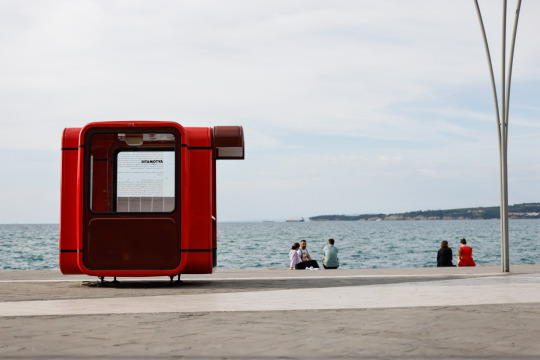
How will we live together when public spaces are sold out? The story is a parable of the fear of the unknown - is it war, isolation or just the fear of being to close to each other?
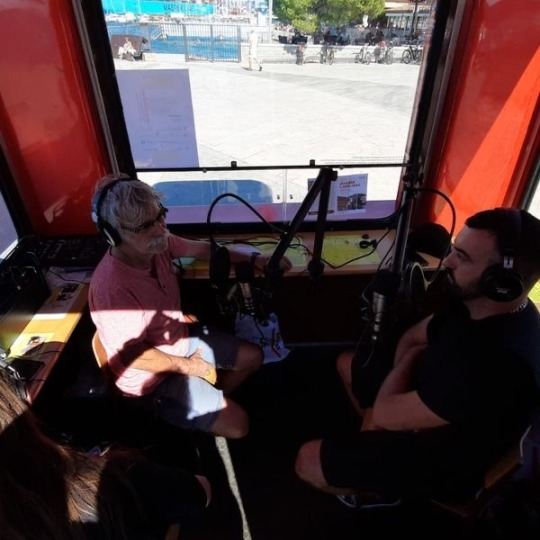

Public talks in K67 with local cultural and political figures transmitted live on-air of Independent Coastal Radio NOR.
The utopia starts in projects that are going beyond the expected rules. It points out the neuralgic problems of the location and seeks the analysis of the current state of matter. One of the utopias stands in a small Slovenian coastal town Koper - in a public square where a parking lot is situated on the most prominent position next to the sea.
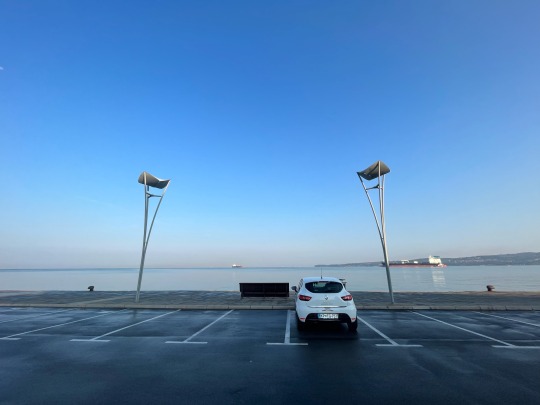
The utopia - K67 kiosk, designed by Saša Mächtig in 1967, concludes its story with the absurdity of the use of the public square next to the sea in favor of parking. As the writer and journalist Martin Reichert, to whom we dedicated this project, would say, “it is a parking lot with the most beautiful view in the world."

K67 is one of the best examples of design during the former Yugoslavia. In the context of the presentation in the public space, with the help of the owner Coastal Galleries Piran, it was placed on the square in Koper in December 2021, in order to become a new generator for its urban content.


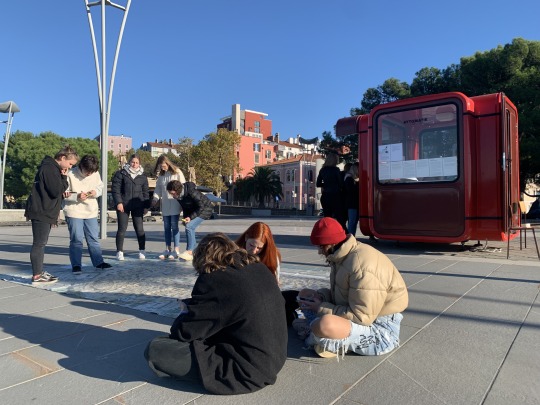
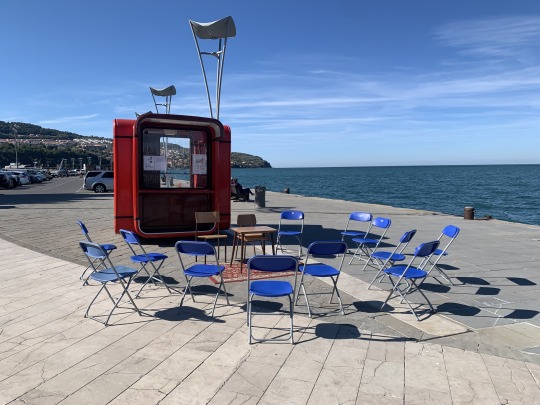
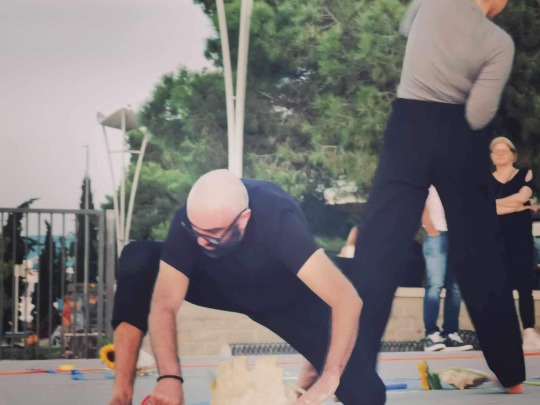

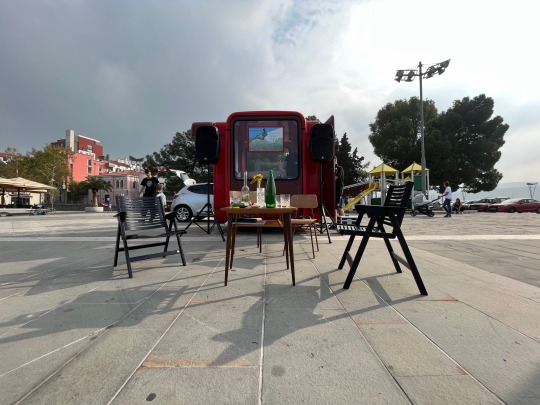
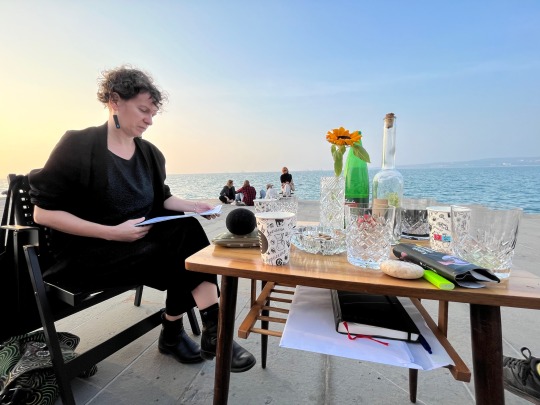
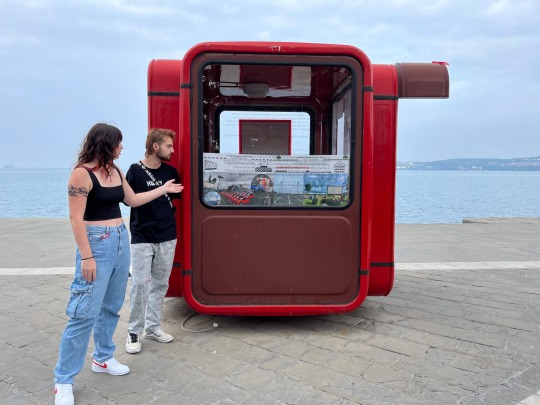

youtube
From spring to late autumn 2023, a process of tactical and performative urbanism took part in the K67 in favour to create an inclusive public space. The main concept proposed and elaborated within the municipality was based on the change of the current parking lot on the square into a green community space.
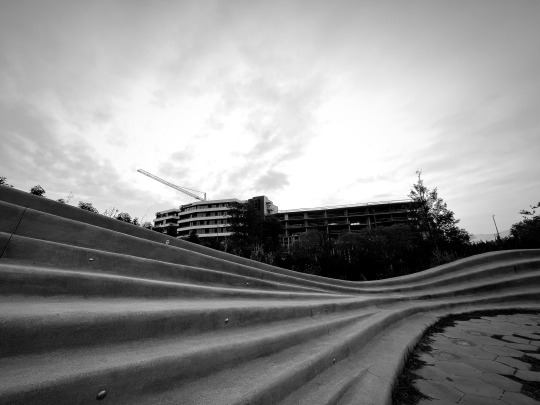
Unfinished project Solis was more than ten years a failure of a PPP concept. After COVID the investor succeeded to add two more floors of the private apartments.
Tactical urbanism is the opposite of investment urbanism, which has a dispersed structure of activity in space and builds various, mainly residential buildings that sell well, but without a well-thought-out placement in the context of the city. The last plan for Koper was signed by the architect Edo Mihevc in the 1960s.
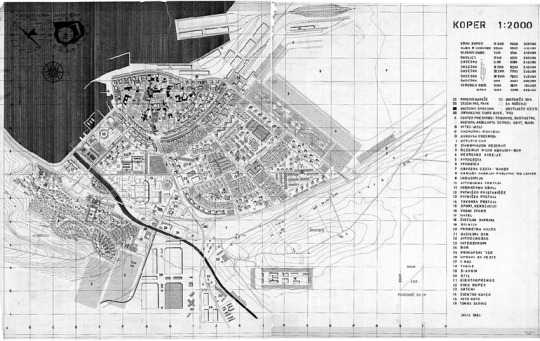
Urban Plan for Koper, Edo Mihevc (1961). | Source © Neža Čebron Lipovec

The renovation of the new roof for the city market was executed via the municipality but without a public competition.
Today it looks like investor urbanism is much faster than the concept of town planning per se. This results in a fact that there is no more urban planning in the city of Koper today.

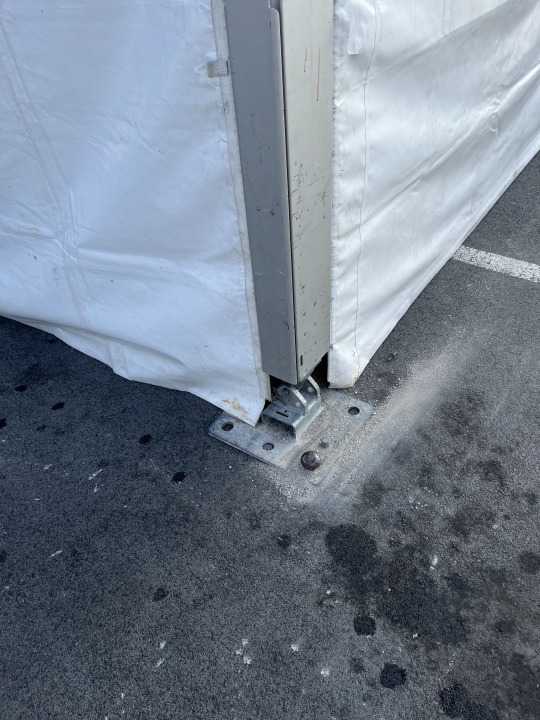
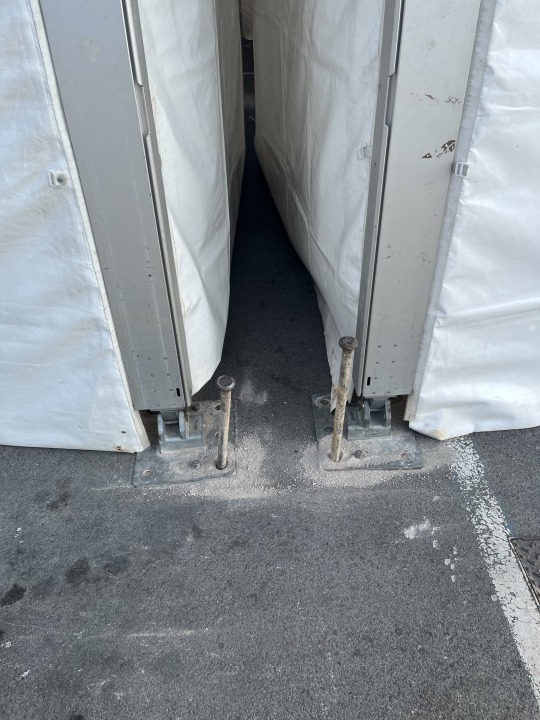
The farm market with live animals in plastic tent on Ukmarjev square shows the discrepancy of communication between the municipality and experts.
In Koper as in other towns across the Adriatic coast there is an obvious pressure from investor urbanism. Public spaces are mostly touristized, privatized and don’t belong to dwellers anymore. Therefore is important to ensure that buildings are not built without public competitions. The K67 stays a reminder of a utopia that shall make aware of the importance of reuse and creation of community spaces.

The cruise ships don't need to pay tax in Koper so instead of Venice, were are banned are welcomed for a pollution of cruise tourism.

The utopia K67 is dedicated to the writer and journalist Martin Reichert.
29 notes
·
View notes
Text
Del’s Favourite Songs Poll: 1960s
Continuing my favourite songs per decade polls, next up is the 60s! The no winners rule definitely affected this one - but it did make me realise that I'm really not that fussed by the early 60s once you take out Dansevise and Nous les amoureux
Songs under the cut:
youtube
youtube
youtube
youtube
youtube
5 notes
·
View notes
Text
US HEGEMONY and OUT RIGHT TERRORISM
The Chinese Embassy has published a list of states that were bombed by the United States of America after World War II:
Japan 6.08 and 9.08 1945
Korea and China 1950-53 (Korean War)
Guatemala 1954
Indonesia (1958)
Cuba (1959-1961)
Guatemala (1960)
Congo (1964)
Laos (1964-1973)
Vietnam (1961-1973)
Cambodia (1969-1970)
Guatemala (1967-1969)
Grenada (1983)
Lebanon (1983, 1984) (hitting targets in the territories of Lebanon and Syria)
Libya (1986)
Salvador (1980)
Nicaragua (1980)
Iran (1987)
Panama (1989)
Iraq (1991) (Gulf War)
Kuwait (1991)
Somalia (1993)
Bosnia (1994, 1995)
Sudan (1998)
Afghanistan (1998)
Yugoslavia (1999)
Yemen (2002)
Iraq (1991-2003) (joint US and British troops)
Iraq (2003-2015)
Afghanistan (2001-2015)
Pakistan (2007-2015)
Somalia (2007-2008, 2011)
Yemen (2009, 2011)
Libya (2011, 2015)
Syria (2014-2015)
There are more than 20 states on the list. China urged "never forget who is the real threat to the world."
Were there outrages from the Western community regarding the United States?
Were there loud accusatory cries?
Were there sanctions against the United States at least once?
This whole hypocritical world caudle sits quietly with its tongue in one place, when the USA nightmares countries like a real bandit. Not an exclamation, not a shadow of reproach, not a glimmer of indignation. Cowardly, shameless, hypocritical creatures! I would spit on everyone in his hypocritical mug and would poke his nose into this list.
This list should be broadcast continuously on all channels 24 hours a day. Make videos that would gouge all this Western riff-raff, remind every fact of the US crime against other countries.
5 notes
·
View notes
Text
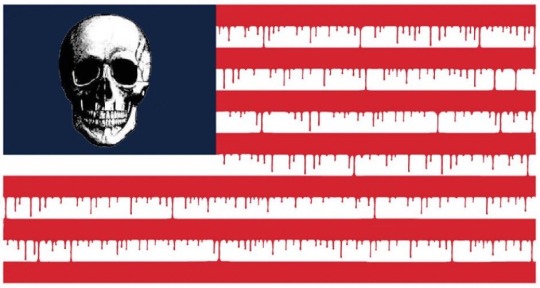


US military, CIA coups and clandestine operations in foreign countries since WWII:
🇮🇷 Iran: 1946
🇨🇳 China: 1946-1949
🇬🇷 Greece: 1947-1949
🇮🇹 Italy: 1948
🇵🇭 Philippines: 1948-1954
🇰🇵 Korea: 1950-1953
🇮🇷 Iran: 1953
🇻🇳 Vietnam: 1954
🇬🇹 Guatemala: 1954
🇱🇧 Lebanon: 1958
🇵🇦 Panama: 1958
🇭🇹 Haiti: 1959
🇨🇩 Congo: 1960
🇻🇳 Vietnam: 1960-1964
🇨🇺 Cuba: 1961-1962
🇱🇦 Laos: 1962
🇪🇨 Ecuador: 1963
🇵🇦 Panama: 1964
🇧🇷 Brazil: 1964
🇻🇳 Vietnam: 1965-1975
🇮🇩 Indonesia: 1965
🇨🇩 Congo: 1965
🇩🇴 Dominican Republic: 1965
🇱🇦 Laos: 1965-1973
🇬🇭 Ghana: 1966
🇬🇹 Guatemala: 1966-1967
🇰🇭 Cambodia: 1969-1975
🇴🇲 Oman: 1970
🇱🇦 Laos: 1971-1973
🇨🇱 Chile: 1973
🇰🇭 Cambodia: 1975
🇦🇴 Angola: 1976-1992
🇮🇷 Iran: 1980
🇱🇾 Libya: 1981
🇸🇻 El Salvador: 1981-1992
🇳🇮 Nicaragua: 1981-1990
🇱🇧 Lebanon: 1982-1984
🇬🇩 Grenada: 1983
🇭🇳 Honduras: 1983-1989
🇮🇷 Iran: 1984
🇱🇾 Libya: 1986
🇧🇴 Bolivia: 1986
🇮🇷 Iran: 1987-1988
🇱🇾 Libya: 1989
🇵🇭 Philippines: 1989
🇵🇦 Panama: 1989-1990
🇱🇷 Liberia: 1990
🇮🇶 Iraq: 1990-1991
🇮🇶 Iraq: 1991-2003
🇭🇹 Haiti: 1991
🇸🇴 Somalia: 1992-1994
Yugoslavia: 1992-1994
🇧🇦 Bosnia: 1993-1995
🇭🇹 Haiti: 1994-1996
🇭🇷 Croatia: 1995
🇨🇩 Zaire (Congo): 1996-1997
🇱🇷 Liberia: 1997
🇸🇩 Sudan: 1998
🇦🇫 Afghanistan: 1998
Yugoslavia: 1999
🇲🇰 Macedonia: 2001
🇦🇫 Afghanistan: 2001-2021
🇻🇪 Venezuela: 2002
🇮🇶 Iraq: 2003-present
🇭🇹 Haiti: 2004
🇺🇦 Ukraine: 2004, 2013-present
🇵🇸 Palestine: 2006-2007
🇾🇪 Yemen: 2009-present
🇸🇾 Syria: 2005-2009, 2011-present
🇱🇾 Libya: 2011
This is NOT an exhaustive list.
6 notes
·
View notes
Text

“Soarele si luna” (Moldova 2023) VS “Een Beetje” (Netherlands 1959)
“10 Years” (Iceland 2021) VS “Non ho l'età” (Italy 1964)
“I.M” (Israel 2022) VS “Take Me to Your Heaven” (Sweden 1999)
“OPA” (Greece 2010) VS “Nous Les Amoureux” (Luxembourg 1961)
“Wolves of the Sea” (Latvia 2008) VS “Boom Bang-a-Bang” (UK 1969)
“SloMo” (Spain 2022) VS “I Wanna” (Latvia 2002)
“Yodel it! (Romania, 2017) VS “Rock Me” (Yugoslavia 1989)
“Tattoo” (Sweden 2023) VS “Puppet on a String” (UK 1967)
“Kuula” (Estonia 2012) VS “Ding a Dong” (Netherlands 1975)
“Évidemment” (France 2023) VS “La la la” (Spain 1968)
“Zero Gravity” (Australia 2019) VS “Euphoria” (Sweden 2012)
“Stay” (Lithuania 2023) VS “Tu te reconnaîtras” (Luxembourg 1973)
“Together” (Ireland 2018) VS “Fly on the Wings of Love” (Denmark 2000)
“Like It” (Belarus 2019) VS “Molitva” (Serbia 2007)
“When We’re Old” (Lithuania 2018) VS “Making Your Minds Up” (UK 1981)
“City Lights” (Belgium 2017) VS “My Number One” (Greece 2005)
#eurovision#eurovision song contest#tumblr bracket#tumblr polls#eurovisionbracket#esc#tumblr tournament#tumblr poll#tumblr tourney
9 notes
·
View notes
Text
20 Cover Versions
Twenty cover versions of famous songs.

Brandy- Blackhawk (Brandy / Slaughter-Fly Gets The Shaft, 1973) Cover of Brandy (You're a Fine Girl) by Looking Glass
Get Ready - Brenda Parker (Get Ready / My Baby Loves Me, 1971) Cover over the hitsong by The Temptations
Here I Am Come And Take Me - Aubrey Mann & The Lunar 7 (Here I Am Come And Take Me / Spouge Explosion, 1976). Cover of Al Greens hitsong
It's Your Thing - George Semper Rhythm Committee (It's Your Thing / Don't Be Afraid, 1969) Instrumental cover of the hit The Isley Brothers' hit from 1969
Jungle Fever - The Hiltonaires (Made In England 2, 1971) Orginal by Chakachastion (B'ham Rhythm Section, 1977) Cover of Frederick Knight's 1972 version
Let's Stay Together - Don Julian & The Larks (Super Slick, 1974). Cover of Al Greens hitsong
Living For The City - Ceasar Frazier (75, 1975). Instrumental cover of the Stevie Wonders hitsong.
Kissing My Love - Afrique (Soul Makossa, 1973) Cover of Bill Withers' hit
The New Bag - The Exciters (Conozco A Los Dos, 1971). Caribbean cover of the James Brown hit
El País de las 1000 Danzas - Alex y Los Findes (El Pais De Las 1.000 Danzas = Land Of 1.000 Dances, 1967). Spanish cover of Land Of 1.000 Dances
My Sweet Lord - The God Squad Featuring Leonard Caston (Jesus Christ Greatest Hits, 1971) Gospel cover of of the famous George Harrison track
Potkraj Na Les - Alenka Pinterič (Hanibal, 1968) Knock On Wood cover from Yugoslavia
El Sonido de Filadelphia - Orquesta Fascinacion (El Sonido de Filadelphia / En Algun Lugar A Las Puertas Del Cielo, 1974). Cover of TSOP (The Sound Of Philadelphia)
Stasera Canto Io (Funky Broadway) - Patrick Samson Set (Sono Nero, 1968) Cover of Funky Broadway, made famous by Wilson Pickett
Summer Breeze - The Main Ingredient (Euphrates River, 1974). Seals & Crofts hitsong
Superstition - The Airmen Of Note (Brothers In Blue, 1974). Instrumental cover of Stevie Wonders hit song
Superstition - Blooblo (Reggae Party Time, 1973). Another instrumental cover of Stevie Wonders hit song
El Tiempo Apremia = Time Is Tight - Los Lazos (Como Has Hecho, 1970). 1969 hit by Booker T and The MG's
The Times They Are A Changing - The Brothers & Sisters (Dylan's Gospel, 1969) Gospel version of this Dylan classic
Tighten Up - Al Escobar & His Orchestra (El Sonido Moderno De Al Escobar / The Modern Sounds Of Al Escobar, 1969). Latin version of Archie Bell & The Drells' hitsong
More cover songs
Cover versions
Unusual Cover Versions Of Famous Soul Songs
Unusual cover versions of famous songs
Originals that were less famous than their cover version
Hard to Handle: Top 5 Covers
Sunny: The Best Cover Versions
Yesterday: Soul Covers
Bill Withers Covered
7 notes
·
View notes
Text









POINT BLANK (1967) - The BEAUTY OF ANGIE DICKINSON ON MOVIE POSTERS (Part 10/10)
We conclude this brief overview of Angie Dickinson's talents and beauty with the second film she co-starred with Lee Marvin (see Part 2), i.e. POINT BLANK, one of the best ever Noir movies ever filmed.
Above are the rare Japanese poster and program along with the complete 10 piece Italian fotobusta poster set and other posters from Belgium, Finland, France, Yugoslavia, the UK and the US (Click on each image for details
Director: John Boorman
Actors: Angie Dickinson, Lee Marvin
ALL OUR ANGIE DICKINSON MOVIE POSTERS ARE HERE
If you like this entry, check the other 9 parts of this week’s Blog as well as our Blog Archives
All our NEW POSTERS are here
All our ON SALE posters are here
The posters above courtesy of ILLUSTRACTION GALLERY
#illustraction gallery#illustraction#angie dickinson#point blank#lee marvin#John Boorman#1967#movies#movie poster#japanese movie poster#italian movie poster#fotobusta#belgian movie poster#French movie poster#Finnish movie poster#one sheet movie poster#Yugoslavian movie poster#vintage#film#British movie poster
3 notes
·
View notes
Text
Eurovision Fact #221:
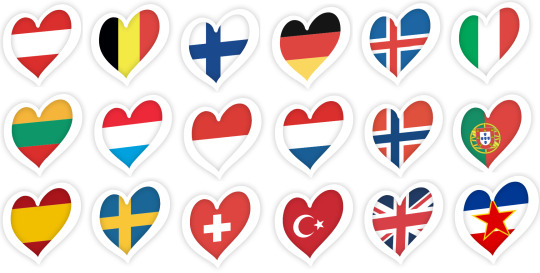
It is fairly common for a nation to receive an overall final score of nul points in the Eurovision Song Contest, but it’s less common for multiple nations to receive zero points during the same competition. Out of the total sixty-six Eurovision Song Contests that have been held, twenty-two have had at least one contestant who earned zero points.
The most contestants receiving nul points in a single contest is four. This happened a total of four times, all in a row, in 1962, 1963, 1964, and 1965.
Austria and Norway are tied for most times earning nul points with a total of 4 losses.
The following is a list of the years in which contestants gained zero points and which nations they were from:
1962: Netherlands, Austria, Spain, and Belgium.
1963: Netherlands, Finland, Sweden, and Norway.
1964: Switzerland, Yugoslavia, Portugal, and Germany.
1965: Spain, Finland, Belgium, and Germany.
1966: Italy and Monaco.
1967: Switzerland.
1970: Luxembourg.
1978: Norway.
1981: Norway.
1982: Finland
1983: Spain and Türkiye.
1987: Türkiye.
1988: Austria.
1989: Iceland.
1991: Austria.
1994: Lithuania
1997: Norway and Portugal
1998: Switzerland.
2003: United Kingdom.
2015: Austria and Germany.
2021: United Kingdom.
[Sources]
Turin 2022 Grand Final Scoreboard, Eurovision.tv.
Rotterdam 2021 Grand Final Scoreboard, Eurovision.tv.
Tel Aviv 2019 Grand Final Scoreboard, Eurovision.tv.
Lisbon 2018 Grand Final Scoreboard, Eurovision.tv.
Kyiv 2017 Grand Final Scoreboard, Eurovision.tv.
Stockholm 2016 Grand Final Scoreboard, Eurovision.tv.
Vienna 2015 Grand Final Scoreboard, Eurovision.tv.
Copenhagen 2014 Grand Final Scoreboard, Eurovision.tv.
Malmö 2013 Grand Final Scoreboard, Eurovision.tv.
Baku 2012 Grand Final Scoreboard, Eurovision.tv.
Düsseldorf 2011 Grand Final Scoreboard, Eurovision.tv.
Oslo 2010 Grand Final Scoreboard, Eurovision.tv.
Moscow 2009 Grand Final Scoreboard, Eurovision.tv.
Belgrade 2008 Grand Final Scoreboard, Eurovision.tv.
Helsinki 2007 Grand Final Scoreboard, Eurovision.tv.
Athens 2006 Grand Final Scoreboard, Eurovision.tv.
Kyiv 2005 Grand Final Scoreboard, Eurovision.tv.
Istanbul 2004 Grand Final Scoreboard, Eurovision.tv.
Riga 2003 Final Scoreboard, Eurovision.tv.
Tallinn 2002 Final Scoreboard, Eurovision.tv.
Copenhagen 2001 Final Scoreboard, Eurovision.tv.
Stockholm 2000 Final Scoreboard, Eurovision.tv.
Jerusalem 1999 Final Scoreboard, Eurovision.tv.
Birmingham 1998 Final Scoreboard, Eurovision.tv.
Dublin 1997 Final Scoreboard, Eurovision.tv.
Oslo 1996 Final Scoreboard, Eurovision.tv.
Dublin 1995 Final Scoreboard, Eurovision.tv.
Dublin 1994 Final Scoreboard, Eurovision.tv.
Millstreet 1993 Final Scoreboard, Eurovision.tv.
Malmö 1992 Final Scoreboard, Eurovision.tv.
Rome 1991 Final Scoreboard, Eurovision.tv.
Zagreb 1990 Final Scoreboard, Eurovision.tv.
Lausanne 1989 Final Scoreboard, Eurovision.tv.
Dublin 1988 Final Scoreboard, Eurovision.tv.
Brussels 1987 Final Scoreboard, Eurovision.tv.
Bergen 1986 Final Scoreboard, Eurovision.tv.
Gothenberg 1985 Final Scoreboard, Eurovision.tv.
Luxembourg 1984 Final Scoreboard, Eurovision.tv.
Munich 1983 Final Scoreboard, Eurovision.tv.
Harrogate 1982 Final Scoreboard, Eurovision.tv.
Dublin 1981 Final Scoreboard, Eurovision.tv.
The Hague 1980 Final Scoreboard, Eurovision.tv.
Jerusalem 1979 Final Scoreboard, Eurovision.tv.
Paris 1978 Final Scoreboard, Eurovision.tv.
London 1977 Final Scoreboard, Eurovision.tv.
The Hague 1976 Final Scoreboard, Eurovision.tv.
Stockholm 1975 Final Scoreboard, Eurovision.tv.
Brighton 1974 Final Scoreboard, Eurovision.tv.
Luxembourg 1973 Final Scoreboard, Eurovision.tv.
Edinburgh 1972 Final Scoreboard, Eurovision.tv.
Dublin 1971 Final Scoreboard, Eurovision.tv.
Amsterdam 1970 Final Scoreboard, Eurovision.tv.
Madrid 1969 Final Scoreboard, Eurovision.tv.
London 1968 Final Scoreboard, Eurovision.tv.
Vienna 1967 Final Scoreboard, Eurovision.tv.
Luxembourg 1966 Final Scoreboard, Eurovision.tv.
Naples 1965 Final Scoreboard, Eurovision.tv.
Copenhagen 1964 Final Scoreboard, Eurovision.tv.
London 1963 Final Scoreboard, Eurovision.tv.
Luxembourg 1962 Final Scoreboard, Eurovision.tv.
Cannes 1961 Final Scoreboard, Eurovision.tv.
London 1960 Final Scoreboard, Eurovision.tv.
Cannes 1959 Final Scoreboard, Eurovision.tv.
Hilversum 1958 Final Scoreboard, Eurovision.tv.
Frankfurt am Main 1957 Final Scoreboard, Eurovision.tv.
Lugano 1956 Final Scoreboard, Eurovision.tv.
#esc facts oc#eurovision#esc#eurovision song contest#eurovision facts oc#nul points#austria#belgium#finland#germany#iceland#italy#Lithuania#luxembourg#monaco#netherlands#norway#portugal#spain#sweden#switzerland#Türkiye#UK#United Kingdom#Yugoslavia
18 notes
·
View notes
Text
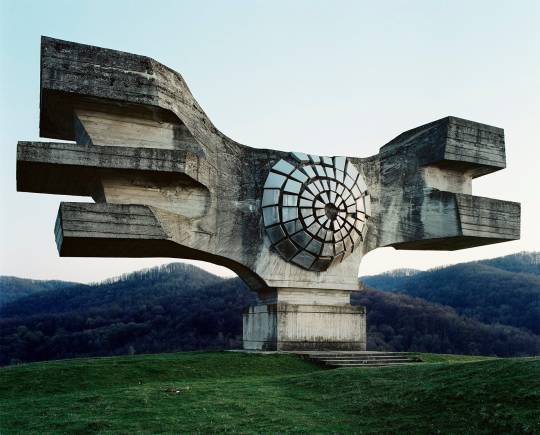
Arguably the most impressive monument from the former Yugoslavia, the ‘Monument to the Revolution of the people of Moslavina’ was designed by sculptor Dušan Džamonja and built in 1967. The monument which stands over 10m tall and 20m wide was dedicated to the people of Moslavina during World War II. The design represents ‘wings of victory’.
Image from the 2010 Spomenik series by Jan Kempenaers.
3 notes
·
View notes
Text
Updated list of my ESC winners
1956: Franca Raimondi - Aprite le finestre (Italy)
1957: Margot Hielscher - Telefon, Telefon (Germany)
1958: Domenico Modugno - Nel blu dipinto di blu (Italy)
1959: Teddy Scholten - Een beetje (Netherlands)
1960: Nora Brockstedt - Voi voi (Norway)
1961: Jean Claude Pascal - Nous les amoureux (Luxembourg)
1962: Marion Rung - Tipi Tii (Finland)
1963: Grethe & Jorgen Ingmann - Dansevise (Denmark)
1964: Gigliola Cinquetti - Non ho l'eta (Italy)
1965: France Gall - Poupee de cire, poupee de son (Luxembourg)
1966: Udo Jurgens - Merci, cherie (Austria)
1967: Sandie Shaw - Puppet on a string (United Kingdom)
1968: Cliff Richard - Congratulations (United Kingdom)
1969: Salome - Vivo cantando (Spain)
1970: Mary Hopkin - Knock knock who's there (United Kingdom)
1971: Severine - Un banc, un arbre, une rue (Monaco)
1972: Vicky Leandros - Apres Toi (Luxembourg)
1973: Anne Marie David - Tu te reconnaitras (Luxembourg)
1974: ABBA - Waterloo (Sweden)
1975: Teach-in - Ding a dong (Netherlands)
1976: Brotherhood of man - Save your kisses for me (United Kingdom)
1977: Monica Aspelund - Lapponia (Finland)
1978: Izhar Cohen - A-Ba-Ni-Bi (Israel)
1979: Milk & Honey - Hallelujah (Israel)
1980: Katja Ebstein - Theater (Germany)
1981: Lena Valaitis - Johnny Blue (Germany)
1982: Anna Vissi - Mono i agapi (Cyprus)
1983: Danijel - Dzuli (Yugoslavia)
1984: Alice & Battiato - I treni di tozeur (Italy)
1985: Bobbysocks - La det swinge (Norway)
1986: Sandra Kim - J'aime la vie (Belgium)
1987: Lilliane Saint Pierre - Soldiers of love (Belgium)
1988: Celine Dion - Ne partez pas sans moi (Switzerland)
1989: Birthe Kjaer - Vi maler byen rod (Denmark)
1990: Toto Cutugno - Insieme 1992 (Italy)
1991: Carola - Fangad av en stormvind (Sweden)
1992: Evridiki - Teriazoume (Cyprus)
1993: Ruth Jacott - Vrede (Netherlands)
1994: CatCat - Bye bye baby (Finland)
1995: Secret Garden - Nocturne (Norway)
1996: Eimear Quinn - The voice (Ireland)
1997: Jalisse - Fiumi di Parole (Italy)
1998: Edsilia Rombley - Hemel en aarde (Netherlands)
1999: Selma - All out of luck (Iceland)
2000: Brainstorm - My star (Latvia)
2001: Nusa Derenda - Energy (Slovenia)
2002: Malene - Tell me who you are (Denmark)
2003: Urban Trad - Sanomi (Belgium)
2004: Ruslana - Wild dances (Ukraine)
2005: Zdob si Zdub - Bunica bate doba (Moldova)
2006: Hari Mata Hari - Lejla (Bosnia & Herzegovina)
2007: Elitsa Todorova & Stoyan Yankulov - Water (Bulgaria)
2008: Mor ve otesi - Deli (Turkey)
2009: Alexander Rybak - Fairytale (Norway)
2010: Paula Seling & Ovi - Playing with fire (Romania)
2011: Eldrine - One more day (Georgia)
2012: Kaliopi - Crno i belo (North Macedonia)
2013: Zlata Ognevich - Gravity (Ukraine)
2014: Sebalter - Hunter of stars (Switzerland)
2015: Mans Zelmerlow - Heroes (Sweden)
2016: Iveta Mukuchyan - Lovewave (Armenia)
2017: Joci Papai - Origo (Hungary)
2018: Yianna Terzi - Oniro Mou (Greece)
2019: Keiino - Spirit in the sky (Norway)
2020: The Roop - On fire (Lithuania)
2021: Maneskin - Zitti e buoni (Italy)
2022: Zdob si Zdub & Fratii Advahov - Trenuletul (Moldova)
6 notes
·
View notes
Text
Events 9.10 (after 1940)
1942 – World War II: The British Army carries out an amphibious landing on Madagascar to re-launch Allied offensive operations in the Madagascar Campaign.
1943 – World War II: In the course of Operation Achse, German troops begin their occupation of Rome.
1960 – At the Summer Olympics in Rome, Abebe Bikila becomes the first sub-Saharan African to win a gold medal, winning the marathon in bare feet.
1961 – In the Italian Grand Prix, a crash causes the death of German Formula One driver Wolfgang von Trips and 15 spectators who are hit by his Ferrari, the deadliest accident in F1 history.
1967 – The people of Gibraltar vote to remain a British dependency rather than becoming part of Spain.
1974 – Guinea-Bissau gains independence from Portugal.
1976 – A British Airways Hawker Siddeley Trident and an Inex-Adria DC-9 collide near Zagreb, Yugoslavia, killing 176.
1977 – Hamida Djandoubi, convicted of torture and murder, is the last person to be executed by guillotine in France.
2000 – Operation Barras successfully frees six British soldiers held captive for over two weeks and contributes to the end of the Sierra Leone Civil War.
2001 – Antônio da Costa Santos, mayor of Campinas, Brazil is assassinated.
2001 – During his appearance on the British TV game show Who Wants to be a Millionaire?, contestant Charles Ingram reaches the £1 million top prize, but it was later revealed that he had cheated to the top prize by listening to coughs from his wife and another contestant.
2002 – Switzerland, traditionally a neutral country, becomes a full member of the United Nations.
2007 – Former Prime Minister of Pakistan Nawaz Sharif returns to Pakistan after seven years in exile, following a military coup in October 1999.
2008 – The Large Hadron Collider at CERN, described as the biggest scientific experiment in history, is powered up in Geneva, Switzerland.
2017 – Hurricane Irma makes landfall on Cudjoe Key, Florida as a Category 4, after causing catastrophic damage throughout the Caribbean. Irma resulted in 134 deaths and $64.76 billion (2017 USD) in damage.
2022 – Death of Queen Elizabeth II: King Charles III is formally proclaimed as monarch at a meeting of the Accession Council in St James's Palace.
0 notes
Text


WHEN #EGYPT SAVED REFUGEES FROM EUROPE.

El Shatt, the United Nations Relief and Rehabilitation Administration's refugee camp for Yugoslavs
Creator(s): Gilmore, Otto, photographer
Date Created/Published: 1944 Sept.
مخيم الشط: هو مجمع من مخيمات اللاجئين في صحراء شبه جزيرة سيناء في مصر، حيث أقام السكان الذين تم إجلاؤهم من دالماتيا من فبراير 1944 إلى مارس 1946.
EL SHATT - the Croatian Refugee Community in the Sinai Desert,
Egypt (1944-1946)
Search Results: "LOT 2183" - Prints & Photographs Online Catalog (Library of Congress) (loc.gov)
web.archive.org/web/20110721100420/http://www.hismus.hr/english/el shatt eng.htm
Building Yugoslavia in the Sand? Dalmatian Refugees in Egypt, 1944–1946
Building Yugoslavia in the Sand? Dalmatian Refugees in Egypt, 1944–1946 | Slavic Review | Cambridge Core
During the last years of the Second World War, some 30,000 Yugoslav refugees found shelter in the Egyptian desert from the German occupation of Dalmatia. In the camp El Shatt, the Partisan movement, the nascent UN, western aid groups, and the British Army worked together to take care of the refugees and also to negotiate future relations. The Communist Party, with victory in Yugoslavia in sight, sought to showcase its ability to organize and motivate its future citizens. Thus, the camps in Egypt became a testing ground for state-building back home. The article will explore the tensions that emerged between the self-confident Partisans, the suspicious British and UN officials, and the refugees, who experienced the end of the war in the Egyptian desert.

Figure 2. Teaching in school, with relief map of Dalmatia made of sand in class in Tolumbat (Credit: UNRRA, UN Archives, S-0800-0008-0008).
EL SHATT NAŠ NEZABORAVLJENI
obljetnica Hrvatskog zbjega n a Sinaju (1944-1994)
Neven Bogdanić,
79922 (srce.hr)
الشط لا ينسى
الذكرى الخمسون للاجئين الكرواتيين في سيناء (1944-1994)
نيفين بوجدانيتش،
December 2005
Ghosts of the Sinai: A quiet memorial recently re-opened in Sinai commemorates Egypt’s forgotten refugees: The 825 Croatians who died at El-Shattdisplaced persons’ camp in the final months of the Second World War. By Cache Seel
et - Full Story (archive.org)
سادت درجة من الحياة الطبيعية: كان هناك 300 حالة زواج في المخيم وولد 650 طفلا لملء الفجوات التي خلفها الموتى، الذين بقيت رفاتهم في سيناء حتى بعد مغادرة الأحياء.
وضع ميسيتش إكليلا من الزهور عند أقدام تمثال الأم دالماتيا في المقبرة التي أعيد افتتاحها حديثا وقرأ بصوت عال الكلمات المكتوبة عليه: "الوطن لا ينسى". وقال: "منذ أكثر من 60 عاما ، جلبتهم رياح الحرب إلى هنا ، ويبدو أن الحرب قد تبعتهم حتى خارج الحدود بين الحياة والموت".
خلال 60 عاما من وجوده ، فقد النصب التذكاري في الشط مرتين تقريبا في صراعات أخرى. تم تدمير المقبرة الأصلية والنصب التذكاري خلال الاحتلال الإسرائيلي لشبه الجزيرة في حرب عام 1967. بعد أن استعادت مصر سيناء ، أعادت الحكومة اليوغوسلافية (التي كانت كرواتيا جزءا منها في ذلك الوقت) بناء المقبرة ، مع الجدار الخارجي على شكل نجمة بارتيزان خماسية ، وأعادت تسميتها مقبرة حرب بارتيزان اليوغوسلافية.
احتفل حفل هذا العام بذكرى الانتهاء من التجديدات وتكريس الجدار التذكاري الجديد. اليوم ، يحيط نصبان نصفان محطمان بالأم دالماتيا كتذكير بالأوقات التي فقدت فيها ذكريات هؤلاء الأشخاص تقريبا.
وشكر ميسيتش جميع سكان مصر وكرواتيا الذين عملوا على التجديد، ثم أضاف:
"أشكر جميع الأشخاص الذين ساعدوا في الحفاظ على ذكرى مئات اللاجئين، بعضهم حرفيا في بداية حياتهم، والذين لم يعودوا أبدا إلى ديارهم من مساحات سيناء البعيدة".
Nenad N. Bach 2006


El Shatt, the United Nations Relief and Rehabilitation Administration’s refugee camp for Yugoslavs


An Aid Worker's Snapshots of the El Shatt Croatian Refugee Camp (1944-1946) - Flashbak


El Shatt, the United Nations Relief and Rehabilitation Administration's refugee camp for Yugoslavs
Creator(s): Gilmore, Otto, photographer -Sep., 1944.
Ninoslav Lovčević. 2009. Pustinjska priča – El Shatt
Pustinjska priča - El Šat (PUSTINJSKA PRIČA - EL SHATT) - Film - mojtv.net
Pustinjska priča - El Šat (PUSTINJSKA PRIČA - EL SHATT, 2009) (mojtv.net)
#refugee#refugees#croatia#EGYPT#unhcr#UNRWA#BIDEN#BIDENTRUMP#BREAKING#NEWS#ART#artist#europe#euro 2024#interview with the vampire#eurovision#euro cup#wow#OTD#VINTAGE#vintage photos#formula 1#f1
1 note
·
View note